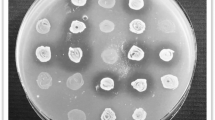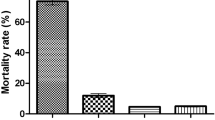Abstract
The study was devoted to the comparison of the probiotic effect of enterococcal Enterococcus faecium L3 to the antibiotic enramycin as a chicken feed additive. Two hundred and sixteen chickens were divided into three groups and tested by different parameters including weight gain, food consumption, blood biochemistry, immunology, and caecal microbiome at two checkpoints, 21 and 39 days after birth. By the end of the experiment, a group of chickens getting probiotic demonstrated weight gain of more than 100 g at the average relative to the control group with no additive in animal feed (P < 0.05). Blood serum biochemistry showed a significant increase in HDL level (P < 0.05) relative to the control group. The 16S RNA sequencing demonstrated the growth abundance of Lachnospiraceae and the decrease of Proteobacteria in probiotic fed group. On the contrary, the antibiotic fed group showed a noticeable increase in the abundance of Proteobacteria which included the genus Salmonella. Thus, probiotic E. faecium L3 being added to chicken food as a single additive may be considered as a possible replacement of antibiotic enramycin.







Similar content being viewed by others
Data Availability
Data are presented either in the manuscript or in the Supplementary material section.
References
Rychlik I (2020) Composition and function of chicken gut microbiota. Animals 10(1):103. https://doi.org/10.3390/ani10010103
Oakley BB, Lillehoj HS, Kogut MH, Kim WK, Maurer JJ, Pedroso A et al (2014) The chicken gastrointestinal microbiome. FEMS Microbiol Lett 360(2):100–112. https://doi.org/10.1111/1574-6968.12608
Costa MC, Bessegatto JA, Alfieri AA, Weese JS, Filho JAB, Oba A (2017) Different antibiotic growth promoters induce specific changes in the cecal microbiota membership of broiler chicken. PLoS ONE 12(2):e0171642. https://doi.org/10.1371/journal.pone.0171642
Butaye P, Devriese Luc A, Haesebrouck F (2003) Antimicrobial growth promoters used in animal feed: effects of less well known antibiotics on grampositive bacteria. Clin Microbiol Rev 16(2):175–188. https://doi.org/10.1128/CMR.16.2.175-188.2003
Salaheen S, Kim S-W, Haley BJ, Van Kessel JAS, Biswas D (2017) Alternative growth promoters modulate broiler gut microbiome and enhance body weight gain. Front Microbiol 8:2088. https://doi.org/10.3389/fmicb.2017.02088
Clavijo V, Flórez MJV (2018) The gastrointestinal microbiome and its association with the control of pathogens in broiler chicken production: a review. Poultry Sci 97(3):1006–1021. https://doi.org/10.3382/ps/pex359
Salim HM, Huque KS, Kamaruddin KM, Beg M (2018) Global restriction of using antibiotic growth promoters and alternative strategies in poultry production. Sci prog 101(1):52–75. https://doi.org/10.3184/003685018x15173975498947
Smith JM (2014) A review of avian probiotics. J Avian Med Surg 28(2):87–94. https://doi.org/10.1647/2012-031
Karaseva A, Tsapieva A, Pachebat J, Suvorov A (2016) Draft genome sequence of probiotic Enterococcus faecium strain L-3. Genome Announc 4(1). https://doi.org/10.1128/genomeA.01622-15
Ermolenko EI, Abdurasulova IN, Kotyleva MP, Svirido DA, Matsulevich AV, Karaseva AB et al (2018) Effects of indigenous Enterococci on the intestinal microbiota and the behavior of rats on correction of experimental dysbiosis. Neurosci Behav physiol 48(4):496–505. https://doi.org/10.1007/s11055-018-0591-7
Abdurasulova I, Matsulevich A, Tarasova E, Kudryavtsev I, Serebrjakova M, Ermolenko E et al (2016) Enterococcus faecium strain L-3 and glatiramer acetate ameliorate experimental allergic encephalomyelitis in rats by affecting different populations of immune cells. Benef Microbes 7(5):719–729. https://doi.org/10.3920/BM2016.0018
Suvorov A (2013) Gut microbiota, probiotics, and human health. Biosci Microbiota Food Health 32(3):81–91. https://doi.org/10.12938/bmfh.32.81
Baryshnikova NEE, Svarval A, Ferman R, Colobov A et al (2017) Enterococcus faecium L-3 in eradication of Helicobacter pylori: in-vivo and in-vitro. Int J Clin Med Microbiol 2:123. https://doi.org/10.15344/2456-4028/2017/123
Magoč T, Salzberg SL (2011) FLASH: fast length adjustment of short reads to improve genome assemblies. Bioinformatics 27(21):2957–2963. https://doi.org/10.1093/bioinformatics/btr507
Belote BL, Tujimoto-Silva A, Hümmelgen PH, Sanches AWD, Wammes JCS, Hayashi RM, Santin E (2018) Histological parameters to evaluate intestinal health on broilers challenged with Eimeria and Clostridium perfringens with or without enramycin as growth promoter. Poult Sci 1:97(7):2287–2294. https://doi.org/10.3382/ps/pey064
Muaz K, Riaz M, Akhtar S, Park S, Ismail A (2018) Antibiotic residues in chicken meat: global prevalence, threats, and decontamination strategies: a review. J Food Prot 81(4):619–627. https://doi.org/10.4315/0362-028x.jfp-17-086
Zhou Y, Li Y, Zhang L, Wu Z, Huang Y, Yan H et al (2020) Antibiotic administration rand oral exposure to antibiotic resistant bacteria as key drivers for gut microbiota disruption and resistome in poultry. Front Microbiol 11:1319. https://doi.org/10.3389/fmicb.2020.01319
Mehdi Y, Létourneau-Montminy MP, Gaucher ML, Chorfi Y, Suresh G, Rouissi T et al (2018) Use of antibiotics in broiler production: global impacts and alternatives. Anim Nutr 4(2):170–178. https://doi.org/10.1016/j.aninu.2018.03.002
Fuller R (1989) Probiotics in man and animals. J Appl Bacteriol 66(5):365–378. https://doi.org/10.1111/j.1365-2672.1989.tb05105.x
Rubio LA (2019) Possibilities of early life programming in broiler chickens via intestinal microbiota modulation. Poultry Sci 98(2):695–706. https://doi.org/10.3382/ps/pey416
Khan S, Moore RJ, Stanley D, Chousalkar KK, Ercolini D (2020) The gut microbiota of laying hens and its manipulation with prebiotics and probiotics to enhance gut health and food safety. Appl Environ Microbiol 86(13):e00600–20. https://doi.org/10.1128/AEM.00600-20
Shin MS, Han SK, Ji AR, Kim KS, Lee WK (2008) Isolation and characterization of bacteriocin-producing bacteria from the gastrointestinal tract of broiler chickens for probiotic use. J Appl Microbiol 105(6):2203–2212. https://doi.org/10.1111/j.1365-2672.2008.03935.x
Taheri HR, Moravej H, Tabandeh F, Zaghari M, Shivazad M (2009) Screening of lactic acid bacteria toward their selection as a source of chicken probiotic. Poultry Sci 88(8):1586–1593. https://doi.org/10.3382/ps.2009-00041
García-Hernández Y, Pérez-Sánchez T, Boucourt R, Balcázar JL, Nicoli JR, Moreira-Silva J et al (2016) Isolation, characterization and evaluation of probiotic lactic acid bacteria for potential use in animal production. Res Vet Sci 108:125–132. https://doi.org/10.1016/j.rvsc.2016.08.009
Stern NJ, Svetoch EA, Eruslanov BV, Perelygin VV, Mitsevich EV, Mitsevich IP et al (2006) Isolation of a Lactobacillus salivarius strain and purification of its bacteriocin, which is inhibitory to Campylobacter jejuni in the chicken gastrointestinal system. Antimicrob Agents Chemother 50(9):3111–3116. https://doi.org/10.1128/aac.00259-06
Wang W, Cai H, Zhang A, Chen Z, Chang W, Liu G et al (2020) Enterococcus faecium modulates the gut microbiota of broilers and enhances phosphorus absorption and utilization. Animals 10(7):1232. https://doi.org/10.3390/ani10071232
Cisek AA, Binek M. (2014) Chicken intestinal microbiota function with a special emphasis on the role of probiotic bacteria. Pol J Vet Sci 17(2):385–94. https://doi.org/10.2478/pjvs-2014-0057. PMID: 24988871
Wu Y, Zhen W, Geng Y, Wang Z, Guo Y (2019) Effects of dietary Enterococcus faecium NCIMB 11181 supplementation on growth performance and cellular and humoral immune responses in broiler chickens. Poultry Sci 98(1):150–163. https://doi.org/10.3382/ps/pey368
Makled MN, Abouelezz KFM, Gad-Elkareem AEG, Sayed AM (2019) Comparative influence of dietary probiotic, yoghurt, and sodium butyrate on growth performance, intestinal microbiota, blood hematology, and immune response of meattype chickens. Trop Anim Health Prod 51(8):2333–2342. https://doi.org/10.1007/s11250-019-01945-8
Forte C, Manuali E, Abbate Y, Papa P, Vieceli L, Tentellini M et al (2018) Dietary Lactobacillus acidophilus positively influences growth performance, gut morphology, and gut microbiology in rurally reared chickens. Poultry Sci 97(3):930–936. https://doi.org/10.3382/ps/pex396
Khajeh Bami M, Afsharmanesh M, Ebrahimnejad H (2020) Effect of dietary Bacillus coagulans and different forms of zinc on performance, intestinal microbiota, carcass and meat quality of broiler chickens. Probiotics Antimicrob proteins 12(2):461–472. https://doi.org/10.1007/s12602-019-09558-1
Chen F, Gao SS, Zhu LQ, Qin SY, Qiu HL (2018) Effects of dietary Lactobacillus rhamnosus CF supplementation on growth, meat quality, and microenvironment in specific pathogen-free chickens. Poultry Sci 97(1):118–123. https://doi.org/10.3382/ps/pex261
Jadhav K, Sharma KS, Katoch S, Sharma VK, Mane B (2015) Probiotics in broiler poultry feeds: a review. Int J AnimVet Sci 1:04–16
Lan RX, Lee SI, Kim IH (2017) Effects of Enterococcus faecium SLB 120 on growth performance, blood parameters, relative organ weight, breast muscle meat quality, excreta microbiota shedding, and noxious gas emission in broilers. Poultry Sci 96(9):3246–3253. https://doi.org/10.3382/ps/pex101
Ermolenko EI, Desheva YA, Kolobov AA, Kotyleva MP, Sychev IA, Suvorov AN (2019) Anti-influenza activity of enterocin B in vitro and protective effect of bacteriocinogenic enterococcal probiotic strain on influenza infection in mouse model. Probiotics Atimicrob proteins 11(2):705–712. https://doi.org/10.1007/s12602-018-9457-0
Abdurasulova IN, Matsulevich AV, Tarasova EA, Kudryavtsev IV, Serebrjakova MK, Ermolenko EI, Bisaga GN, Klimenko VM, Suvorov AN (2016) Enterococcus faecium strain L-3 and glatiramer acetate ameliorate experimental allergic encephalomyelitis in rats by affecting different populations of immune cells. Benef Microbes 30:7(5):719–729. https://doi.org/10.3920/BM2016.0018
Di Pierro F, Bertuccioli A, Saponara M, Ivaldi L (2020) Impact of a two-bacterial-strain formula, containing Bifidobacterium animalis lactis BB-12 and Enterococcus faecium L3, administered before and after therapy for Helicobacter pylori eradication. Minerva Gastroenterol Dietol 66(2):117–123. https://doi.org/10.23736/S1121-421X.19.02651-5
Di Pierro F, Basile I, Danza ML, Venturelli L, Contini R, Risso P, Colombo M (2018) Use of a probiotic mixture containing Bifidobacterium animalis subsp. lactis BB12 and Enterococcus faecium L3 in atopic children. Minerva Pediatr 70(5):418–424. https://doi.org/10.23736/S0026-4946.18.05203-9
Lo Skiavo LA, Gonchar NV, Fedorova MS, Suvorov AN (2013) Dynamics of contamination and persistence of Clostridium difficile in intestinal microbiota in newborn infants during antibiotic therapy and use of probiotic strain Enterococcus faecium L3. Antibiot Khimioterapy 58(11–12):13–18
Fang X, Tiyanont K, Zhang Y, Wanner J, Boger D, Walker S (2006) The mechanism of action of ramoplanin and enduracidin. Mol Biosyst 2(1):69–76. https://doi.org/10.1039/b515328j
Yang J, Huang K, Wang J, Wu D, Liu Z, Yu P et al (2021) Combined use of Bacillus subtilis yb-114,246 and Bacillus licheniformis yb-214,245 improves body growth performance of chinese huainan partridge shank chickens by enhancing intestinal digestive profiles. Probiotics Antimicrob Proteins 13(2):327–342. https://doi.org/10.1007/s12602-020-09691-2
Arumugam M, Raes J, Pelletier E, Le Paslier D, Yamada T, Mende DR et al (2011) Enterotypes of the human gut microbiome. Nature 473(7346):174–180. https://doi.org/10.1038/nature09944
Cani PD (2014) Metabolism in 2013: the gut microbiota manages host metabolism. Nat Rev Endocrinol 10(2):74–76. https://doi.org/10.1038/nrendo.2013.240
Rajilić-Stojanović M, de Vos WM (2014) The first 1000 cultured species of the human gastrointestinal microbiota. FEMS Microbiol Rev 38(5):996–1047. https://doi.org/10.1111/1574-6976.12075
Kubasova T, Kollarcikova M, Crhanova M, Karasova D, Cejkova D, Sebkova A et al (2019) Gut anaerobes capable of chicken caecum colonisation. Microorganisms 7(12):597. https://doi.org/10.3390/microorganisms7120597
Funding
The work was supported by Federal Ministry of Science and higher education: 0557–2019-0002 and funded by “Agricultural scientific and technological innovation project of Shandong Academy of Agricultural Sciences” (Grant ID CXGC2017A01), “Agricultural scientific and technological innovation project of Shandong Academy of Agricultural Sciences” (Grant ID CXGC2017B06), “Open Grant of Beijing Advanced Innovation Center for Food Nutrition and Human Health” (Grant ID 20182024) and “Double Hundred” Program for Foreign Experts of Shandong Province (Grant ID WST2017004).
Author information
Authors and Affiliations
Corresponding author
Ethics declarations
Competing Interests
The authors declare no competing interests.
Additional information
Publisher's Note
Springer Nature remains neutral with regard to jurisdictional claims in published maps and institutional affiliations.
Supplementary Information
Below is the link to the electronic supplementary material.
Rights and permissions
Springer Nature or its licensor holds exclusive rights to this article under a publishing agreement with the author(s) or other rightsholder(s); author self-archiving of the accepted manuscript version of this article is solely governed by the terms of such publishing agreement and applicable law.
About this article
Cite this article
Suvorov, A., Zhao, S., Leontieva, G. et al. Evaluation of the Efficacy of Enterococcus faecium L3 as a Feed Probiotic Additive in Chicken. Probiotics & Antimicro. Prot. 15, 1169–1179 (2023). https://doi.org/10.1007/s12602-022-09970-0
Accepted:
Published:
Issue Date:
DOI: https://doi.org/10.1007/s12602-022-09970-0




